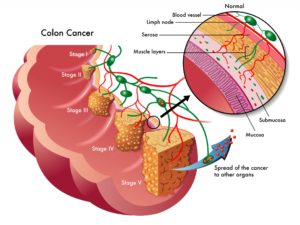 Overview
Overview
Colo-Rectal cancer is a term used to refer to cancer that develops in the colon or the rectum. The colon and rectum are parts of the digestive system.
The first and major part of the large bowel, i.e. the colon, continues to absorb water and mineral nutrients from the food matter and serves as a storage place for waste matter. The waste matter left after this process is feces and goes into the rectum, the final 6 inches of the large bowel. From here it passes out of the body through the anus.
The colon has four sections
(a) The first section is called the ascending colon
(b) The second section is called transverse colon.
(c) The third colon is called descending colon.
(d) The fourth part is called the sigmoid colon. The sigmoid colon joins the rectum, which in turn joins the anus, or the opening where waste matter passes out of the body.
The walls of each of these sections of the colon and the rectum have several layers of tissue. Colorectal cancer starts in the innermost layer and can grow through some or all of the other layers. In most people Colo-rectal cancers develop slowly over a period of several years. Before the symptoms can be felt.
A vast majority of colo-rectal cancers are adenocarcinoma. These are cancers of the glandular cells that line the inside layer of the wall of the colon and rectum.
Carcinoid tumors develop from specialized hormone producing cells of the intestine.
Gastrointestinal stromal tumors develop from specialized cells in the walls of the colon called the ‘interstitial cells of the cajal’.
Some tumors are benign, others are malignant (cancerous). Although these cancers can be found anywhere in the gastrointestinal tract, they are unusual in the colon.
Lymphomas are cancers of the immune system cells that typically develop in lymph nodes but also may start in the colon and rectum or other organs.
Risk factors
A family history of colorectal cancer
Ethnic background
A personal history of colo-rectal polyps
Chronic inflammatory bowel disease
Ageing
Non-vegetarian diet
Sedentary life-style
Obesity
Diabetes
Smoking
Alcohol intake
Disorderly lifestyle
Signs & Symptoms
A change in bowel habits, such as diarrhea, constipation, or narrowing of the stool that lasts for more than a few days.
A feeling that you need to have a bowel movement that is not relived by doing so.
Rectal bleeding or blood in the stool.
Cramping or steady abdominal pain.
Weakness and fatigue.
Diagnosis as per modern science
Medical history and physical exam.
Sigmoidoscopy, barium enema, colonoscopy.
Blood tests
Biopsy
Ultrasound
CT scan
MRI
Staging
Stage 0 – The cancer is in the earliest stage. It has not spread beyond the inner layer (mucosa) of the colon or rectum. This stage is also known as carcinoma in situ or intramucosal carcinoma.
Stage 1 – The cancer has grown through the mucosa into the submucosa or it may also have grown into the muscularis propria, but it has not spread into nearby lymph nodes or distant sites.
Stage 2 – The cancer has grown through the wall of the colon or rectum into other nearby tissues or organs. It has not yet spread to the nearby lymph nodes or distant sites.
Stage 3 – The cancer has grown through the walls of the colon or rectum or into other nearby tissues or organs and has spread to nearby lymph nodes.
Stage 4 – The cancer has spread to distant organs such as liver, lung, peritoneum, or ovary.

 Overview
Overview
